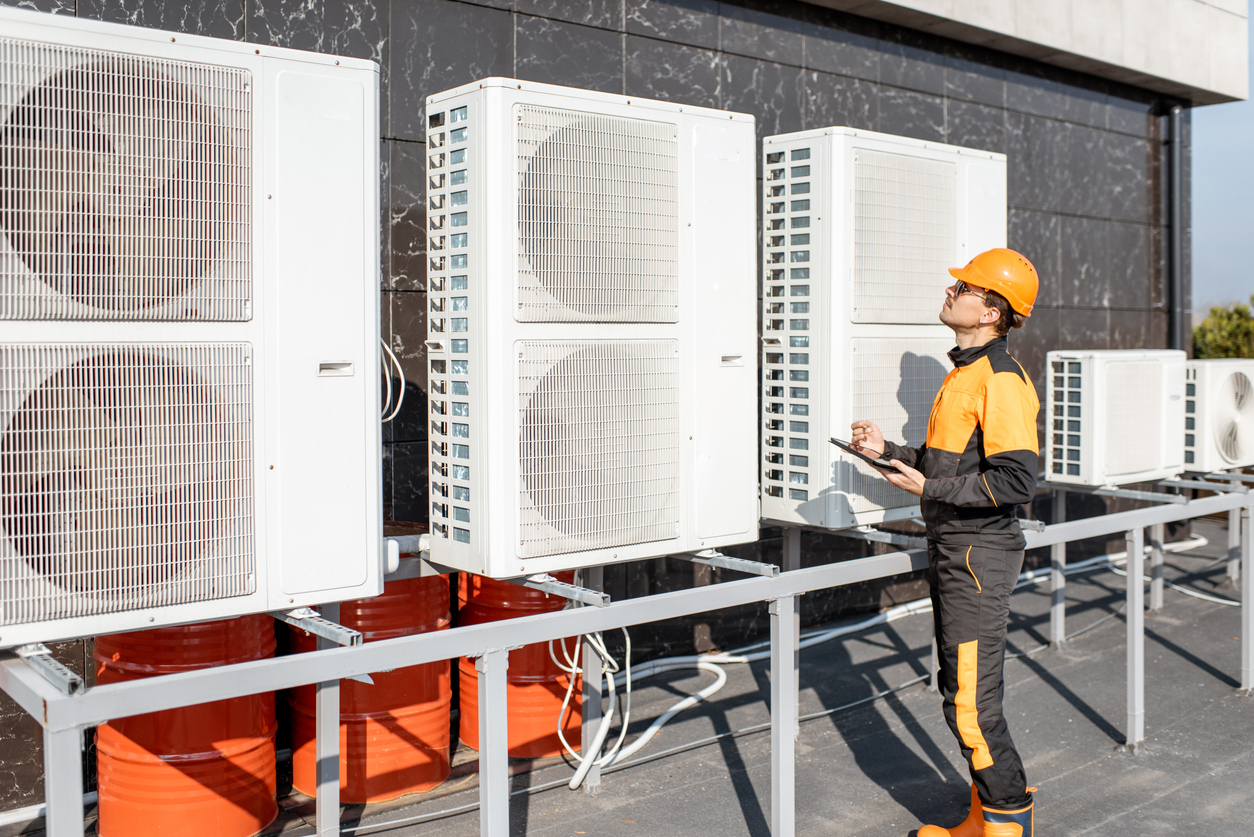
Your choice of heating and cooling system is vital to your home’s design. HVAC (heating, ventilation, and air conditioning) determines your whole-home comfort, air quality, temperature safety, and energy efficiency. When choosing an HVAC system, the first and most important decision is installing a ducted or ductless design. Ducted HVAC is also known as “central air”. It involves hidden ductwork behind the walls and ceiling that circulates cooled or heated air from a central unit. Ductless HVAC systems, also known as “mini-split” involve individual units in each room or zone of your house. Which is right for your home? To help you decide, we’re taking a deep dive into the difference between ducts and ductless HVAC systems.
Ducted HVAC Systems
Central air, forced air, or ducted HVAC systems circulate air through ductwork – special sealed channels for air behind the walls and ceiling.
How HVAC Ducts Work
Ducted HVAC systems distribute conditioned air throughout your home from a central AC and heating unit. The air travels through a network of ducts and comes out vents in the wall, ceiling, or sometimes the floor.
Air balancing uses dampers to ensure rooms further from the central unit get an even distribution of conditioned air for an even temperature throughout.
Advantages
- Whole-Home Heating and Cooling: Ducted HVAC has the advantage of evenly heating or cooling the whole home when the system is well-maintained. Every room or zone will share approximately the same temperature and airflow.
- Aesthetics: Because ducts are behind the walls, the only visible part of ducted HVAC is vent grates.
- Zoning Capabilities: It is possible to use ducted HVAC to create different temperature zones with the right automatic dampers and multi-zone thermostats.
- High Efficiency: Integrated with smart thermostats, ducted HVAC systems can be highly efficient.
Drawbacks
- Installation Complexity: Ducted HVAC works best in homes built with ducts. It is far more complex to add ducts to older homes and houses that do not have ducts.
- Energy Loss: If not properly maintained, ducts can develop leaks which lose heating/cooling/energy efficiency over time by allowing air to escape into uninsulated spaces between the walls.
- Maintenance: Ducted HVAC requires regular cleaning and maintenance of the ductwork.
- Air Quality Risk: If ducts go uncleaned for long periods, they can become the source of dust, allergens, and other poor air quality factors.
Ductless HVAC Systems
Mini-split or ductless HVAC systems involve multiple in-room units that provide on-site heating and cooling without the use of ducts. Zoned temperature control is the signature of ductless HVAC.
How Ductless HVAC Works
Each ductless mini-split unit is connected to a shared outdoor compressor to provide in-room AC capabilities. They also provide individual electric heating, allowing you to heat and cool each room locally. These systems deliver conditioned air directly into specific areas without needing ducts.
Advantages
- Easy Installation: Ductless systems require less installation in homes that do not already have ducts.
- Energy Efficiency: Ductless systems do not need to pump air throughout the house and, therefore, typically have high SEER (Seasonal Energy Efficiency Ratio) ratings.
- Zoning Flexibility: Ductless units can heat or cool one room/zone of the house at a time. You can individually choose temperature settings based on use, comfort, and efficiency.
- Improved Air Quality: Each ductless unit is also an air filter, providing constant air filtration throughout the house.
Drawbacks
- Initial Cost: Ductless mini-split systems tend to have a higher initial cost, though the duct installation cost should also be considered in the balance.
- Aesthetics: Ductless units are wall-mounted and, therefore, are much more visible than vents for hidden ductwork.
- Limited Coverage: Ductless systems do not provide the same evenly distributed heating/cooling the way central air systems can.
Which System Is Right for You?
When considering which type of HVAC system to install in your home, take into account your home’s layout and lifestyle preferences.
- Existing Ductwork: There is a big difference in whether your home already has ductwork. You may need to seal, repair, and rebalance existing ducts for a central air system. However, installing new ducts may be non-ideal in an unducted home.
- Home Size: Ducted HVAC is optimal for larger homes where even temperature management is preferred. Ductless mini-split systems are great for smaller homes where you don’t need many zones.
- Renovations and Additions: Home additions and newly renovated areas may be ideal for ductless systems. Extensive renovations may also be an opportunity to install ducts in a previously ductless home.
- Energy Efficiency: Consider your home’s energy needs and how each system could ensure greater efficiency.
- Aesthetics: Determine if you would prefer invisible ducts or visible mini-split units.
Choosing the Right HVAC System for Your Home
Ducts and ductless HVAC systems have positive qualities and potential drawbacks. The right choice for each home is unique, depending on your home’s layout, whether there is existing ductwork, your available budget, and your personal preferences.
Consulting with an HVAC professional can give you the insights you need to make the right decision for your home and desired heating/cooling experience. Whether you prefer the zoned control of a ductless system or the even distribution of central air, remember that the key to great HVAC performance is always regular inspections, cleaning, and maintenance.
To explore your ideal HVAC solution with a personal consultation, contact us today.


